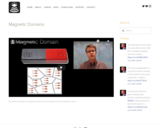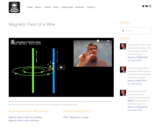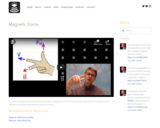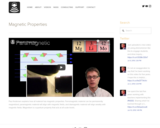
Paul Andersen explains how magnetic domains act as tiny magnets within ferromagnetic material.
- Subject:
- Physical Science
- Physics
- Material Type:
- Lesson
- Provider:
- Bozeman Science
- Date Added:
- 09/22/2016

Paul Andersen explains how magnetic domains act as tiny magnets within ferromagnetic material.

Paul Andersen explains how current moving through a loop of wire can act as an analog for a magnetic dipole. Magnetic dipoles (like compass needles) respond to magnetic fields created by other magnets.

Paul Andersen explains how current moving through a wire will generate a magnetic field tangent to the wire. As the current increases the magnetic field will increase and as the radius from the wire increase the magnitude of the field will decrease.

Students visualize the magnetic field of a strong permanent magnet using a compass. The lesson begins with an analogy to the effect of the Earth's magnetic field on a compass. Students see the connection that the compass simply responds to the Earth's magnetic field since it is the closest, strongest field, and thus the compass responds to the field of the permanent magnets, allowing them the ability to map the field of that magnet in the activity. This information will be important in designing a solution to the grand challenge in activity 4 of the unit.

This lesson introduces students to the effects of magnetic fields in matter addressing permanent magnets, diamagnetism, paramagnetism, ferromagnetism, and magnetization. First students must compare the magnetic field of a solenoid to the magnetic field of a permanent magnet. Students then learn the response of diamagnetic, paramagnetic, and ferromagnetic material to a magnetic field. Now aware of the mechanism causing a solid to respond to a field, students learn how to measure the response by looking at the net magnetic moment per unit volume of the material.

In this fun, engaging activity, students are introduced to a unique type of fluid ferrofluids whose shape can be influenced by magnetic fields! Students act as materials engineers and create their own ferrofluids. They are challenged to make magnetic ink out of ferrofluids and test their creations to see if they work. Concurrently, they learn more about magnetism, surfactants and nanotechnology. As they observe fluid properties as a standalone-fluid and under an imposed magnetic field, they come to understand the components of ferrofluids and their functionality.

Paul Andersen explains how a charge particle will experience a magnetic force when it is moving through a magnetic field. The right-hand rule is described as a method for determining the direction of the force.

Students begin working on the grand challenge of the unit by thinking about the nature of metals and quick, cost-effective means of separating different metals, especially steel. They arrive at the idea, with the help of input from relevant sources, to use magnets, but first they must determine if the magnets can indeed isolate only the steel.

Paul Andersen explains how the magnetic permeability is the ability of a material to form internal magnetic fields. The magnetic permeability of free space is a constant and is much lower than the magnetic permeability of magnetics.

Paul Andersen explains how all material has magnetic properties. Ferromagnetic material can be permanently magnetized, paramagnetic material will align with magnetic fields, and diamagnetic material will align weakly with magnetic fields. Magnetism is a quantum property that acts at all scale levels.

This lesson ties the preceding lessons together and brings students back to the grand challenge question on MRI safety. During this lesson, students focus on the logistics of magnetic resonance imaging as well as the MRI hardware. Students can then integrate this knowledge with their acquired knowledge on magnetic fields to solve the challenge question.

Students explore the basic magnetic properties of different substances, particularly aluminum and steel. There is a common misconception that magnets attract all metals, largely due to the ubiquity of steel in metal products. The activity provides students the chance to predict, whether or not a magnet will attract specific items and then test their predictions. Ultimately, students should arrive at the conclusion that iron (and nickel if available) is the only magnetic metal.

Magnetic fields and their effects on moving electrical charges

Whats happens when a speeding proton goes through a magnetic field

Part 2 of the proton through a magnetic field problem

Magnetic force on a wire carrying current.

The magnetic force that two current-carrying wires exert on each other.

More on the forces exerted by 2 current carrying wires on each other.

The video resource "Magnetism: Crash Course Physics #32" is included in the "Media Literacy" course from the resources series of "Crash Course". Crash Course is a educational video series from John and Hank Green.

Students determine the refractive index of a liquid with a simple technique using a semi-circular hollow block. Then they predict the refractive index of a material (a Pyrex glass tube) by matching it with the known refractive index of a liquid using the percent light transmission measurement. The homemade light intensity detector uses an LED and multimeter, which are relatively inexpensive (and readily available) compared to commercially available measurement instruments.